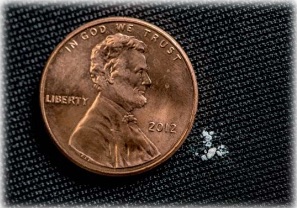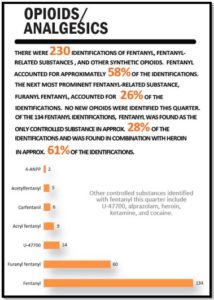
Recently, around 6 a.m. on a Wednesday, several law enforcement agencies executed federal search warrants at three locations in the West End area of Pittsburgh. In one home, when the SWAT team members entered, one of the suspects was trying to escape through a back window. Another one of the suspects knocked over a table where they had been bagging drugs, “causing the powder narcotics to become airborne” and exposing the SWAT officers to the airborne drug. Eighteen of them were taken to the hospital suffering from various symptoms.
According to Brenda Waters of KDKA, the CBS Pittsburgh affiliate, all eighteen were medically cleared. “None of the … law enforcement officers taking part in the early morning raid were adversely affected by the drugs.” The agencies participating in the raid included Pittsburgh Police, Pittsburgh SWAT, U.S. Immigration and Customs, state police and Homeland Security. In addition to the airborne substance, they found more than 1,000 stamp bags, 250 grams of unpackaged drugs and a “significant quantity of white powder” on a plate in the kitchen. The airborne substance was probably fentanyl; maybe carfentanil.
Dr. Tureurro, the chief of Emergency Services at UPMC Mercy Hospital, where the officers were treated, said they were fortunate to get out of the situation quickly, thus minimizing their symptoms. They had burning sensations in their throats; some became lightheaded; others were nauseous. “The big thing that we did for them is we basically decreased the chance that they could be exposed to anything that was laying on their bodies or on their clothes.” By removing their clothes, then showering and decontaminating themselves, the officers decreased their chances of exposure to any of the substance. The Justice Department press release said:
Fentanyl exposure is an all too real risk to law enforcement as we learned this morning. Quick and professional action by first responders helped avert a potential catastrophe.
The Pittsburgh Post-Gazette reported that the raid originated from a May investigation by Customs and Border Protection when agents intercepted a fentanyl package marked as “plastic fittings” that was shipped from Hong Kong. The accused leader of the drug operation had a history of repeated arrests for felony drug convictions and disregarding bond conditions in his repeated arrests for drug related charges. He had been initially arrested for possession and distribution on June 1st in relation to the intercepted package of fentanyl from Hong Kong. He was rearrested on July 20th, discarding a brick of fentanyl on the floor of a police car taking him to jail, and then again on August 2nd. Each time he was released on bond he resumed his criminal activities. This time he did not receive bail.
This is not an isolated or freak occurrence. In September of 2016, The Washington Post reported on a raid in Harford Connecticut when 11 SWAT officers were exposed to airborne fentanyl and heroin. The powder may have blown into the air after the tactical team tossed a flash-bang grenade, or the suspects could have swept the table where they were packaging the drugs. The officers moved through a “cloud of dust in the air.” Several officers were lightheaded, nauseous; they had sore throats and headaches. As a precaution, the entire team went to a local hospital for treatment.
Jim Pasco, executive director of the National Fraternal Order of Police, said this has been an inherent risk for law enforcement for decades, beginning with “The granddaddy of all problems—being exposed to meth labs.” A DEA spokesperson said law enforcement officers are concerned with protecting themselves and the public.
Law enforcement officers do carry a bigger burden than ever — we are fighting to protect the American public from poisons that bring death and destruction to our communities — but we are also faced with challenges of educating the public as to the deadly risks of these substances and about the inextricable links between misuse of prescription opioids to heroin and fentanyl use and addiction.
Kelly Burch reported for The Fix that in May of 2017 when an East Liverpool Ohio police officer helped in the arrest of drug suspects, they tore open bags of the drugs in an attempt to destroy evidence. Back at the station, the officer noticed a white powder on his uniform and tried to brush it away. “I had placed my thumb, and index finger in it and tried to brush it off. I don’t know if it went through my skin or if it became airborne when I wiped it off, or a combination of both.” Within a few minutes, he didn’t feel like himself. The last thing he remembered was falling backwards into the door.
He received a dose of Narcan at the station and a few more at the hospital. “Never in a million years did I think I would be in the hospital for something that serious, for overdosing.” He knew the job was dangerous and might encounter guns and knives. But “you’re not thinking that a particle of dust or drug killing you.” The experience made him even more determined to keep these powerful drugs off the streets: “I am not letting drug dealers win, you may have almost killed me, but you’re not going to win, you’re not going to come to this city and bring that poison.”
Another Ohio encounter with fentanyl took place in early August of 2017 in Massillion, about 50 miles south of Cleveland. Three nurses at the Affinity Medical Center in Massilon lost consciousness while they were cleaning a room where an overdose victim had been treated. All three were treated with naloxone and are said to have recovered. The nurses union at the hospital wanted to meet with hospital officials to discuss protocols for environmental contamination, but the hospital declined, saying it already has effective policies. Hmmm … with three nurses becoming unconscious, it seems a review of the policies woudn’t hurt.
CTV Vancouver reported in October of 2016 that the CBSA, Canada’s Border Services Agency advised its officers to avoid contact with a package they suspect contains fentanyl. The president of Canada’s Customs and Immigration Union said: “What we’re telling our officers at this time, from a health and safety point of view, is that if there’s a package and they think there could fentanyl, they shouldn’t touch it. They shouldn’t approach it.” If an agent believes a package contains the drug, they are advised to give it to supervisors. “We need to approach this so our officers have the right tools, right training and the right equipment.”
In a June 2016 press release, the DEA announced they had released a short Roll Call Video to all law enforcement agencies about the dangers of improperly handling fentanyl. You can watch the video here. The press release said the DEA was concerned about law enforcement coming in contact with fentanyl on the streets in the course of enforcement activities, such as buy-walk or buy-bust operations. “Officers should be aware that while unadulterated fentanyl may resemble cocaine or heroin powder, it can be mixed with other substances which can alter its appearance.” The report noted the current outbreak involved not just fentanyl, but fentanyl compounds (like carfentanil) as well.
Universal precautions must be applied when conducting field-testing on drugs that are not suspected of containing fentanyl. Despite color and appearance, you can never be certain what you are testing. In general, field-testing of drugs should be conducted as appropriate, in a well ventilated area according to commercial test kit instructions and training received. Sampling of evidence should be performed very carefully to avoid spillage and release of powder into the air. At a minimum, gloves should be worn and the use of masks is recommended. After conducting the test, hands should be washed with copious amounts of soap and water. Never attempt to identify a substance by taste or odor.
The DEA published “A Briefing Guide for First Responders” on fentanyl. It contained a history of fentanyl, a description of illicit forms of fentanyl and fentanyl-related substances, the risks of exposure and treatment, as well as decontamination recommendations.
Fentanyl was first synthesized in 1959 by a Belgian chemist. Other forms of pharmaceutical fentanyl were developed for pain management, including a transdermal patch, a nasal spray, a sublingual tab and a flavored lollipop—yes a fentanyl lollipop. While pharmaceutical fentanyl is diverted on a small scale, the current problem is due to transnational criminal organizations competing for the U.S. market.
China and Mexico appear to be the main source countries for illicit fentanyl smuggled into the United States for domestic‐based processing and distribution. Seizures indicate that China supplies lower volumes of high‐purity fentanyl, whereas fentanyl seizures from Mexico are higher volume but lower in purity. Fentanyl is also routed and smuggled through Canada. China‐based trafficking organizations have also been known to use the internet to distribute fentanyl, fentanyl‐related substances, and synthetic opioids globally.
Among the current fentanyl-related substances on the illicit market are: 4‐fluoroisobutyryl fentanyl, furanyl‐fentanyl, acryl‐fentanyl, acetyl‐fentanyl, carfentanil, and 3‐methylfentanyl, and other synthetic opioids such as U‐47700. I’ve written previously on this website about the fentanyl-related substance, carfentanil (“The Devil in Ohio”). Recently I received an unsolicited email from a “company” in Shanghi offering to send me a free sample of carfentanil. The DEA “Briefing Guide for First Responders” warned that some organizations are distributing pure fentanyl.
During the first quarter of 2017 the DEA indentified 230 instances of fentanyl, fentanyl-related substances and other synthetic opioids in seized drug evidence. The following graphic illustrates the results of their analysis. Fentanyl accounted for about 58% of the identifications. Of those 134 fentanyl identifications, 61% of the samples were combined with heroin; 28% were fentanyl alone. Carfentanil was found in six identifications. U-47700, alprazolam (Xanax) and cocaine’s were found in others.
 Because of their hazardous nature, fentanyl and fentanyl-related substances are a serious threat to the health and safety of law enforcement officers and other first responders, such as EMTs. As little as 2-3 milligrams of fentanyl could bring on respiratory depression and possibly death. “When visually compared 2 to 3 milligrams of fentanyl is about the same as five to seven individual grains of table salt.” See the above photo of a penny.
Because of their hazardous nature, fentanyl and fentanyl-related substances are a serious threat to the health and safety of law enforcement officers and other first responders, such as EMTs. As little as 2-3 milligrams of fentanyl could bring on respiratory depression and possibly death. “When visually compared 2 to 3 milligrams of fentanyl is about the same as five to seven individual grains of table salt.” See the above photo of a penny.
The “Briefing Guide for First Responders” went on to describe treatment for any exposure to fentanyl, repeating some of the actions taken in the above situations:
- seek immediate medical attention.
- remove the person from the contaminated environment, preferably where there is fresh air.
- If a suspected fentanyl-related substance has been inhaled, move the person to fresh air.
- If there are overdose symptoms, immediately administer naloxone, which can quickly reverse an opioid overdose.
- Multiple doses may be necessary, depending upon the drug’s purity and potency. Continue to administer a dose of naloxone every 2-3 minutes until the individual is breathing on their own for at least 15 minutes or until EMS arrives.
- Someone who entered a badly contaminated area or was otherwise exposed to a suspected fentanyl-related laboratory or milling operation without wearing the proper protective clothing should undress and shower with soap and water as soon as possible.
- If a suspected fentanyl-related substance was ingested through the mouth or eyes and the person is conscious, rinse their eyes and mouth with cool water.
- When there has been any skin contact, wash the exposed area immediately with soap and water.
- Do NOT use hand sanitizer, as it may contain alcohol, which is a skin penetrant. This may increase the absorption of fentanyl through the skin.
So if you are a first responder or law enforcement officer—or if for some reason you find yourself exposed to fentanyl—remember the above advice. And first responders and law enforcement officers, remember the safety call given by Michael Conrad, who played the role of Sergeant Phil Esterhaus in Hill Street Blues: “Let’s be careful out there.”





